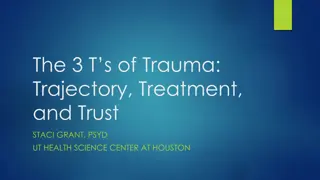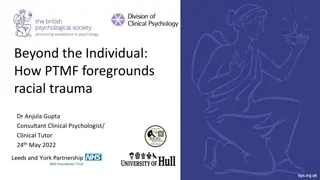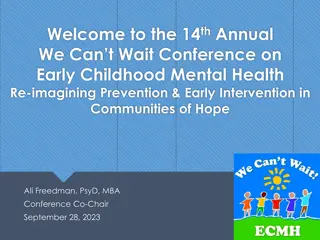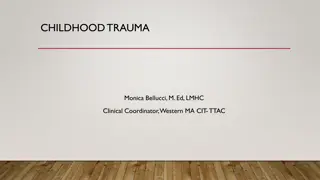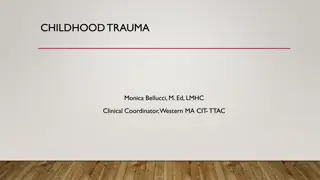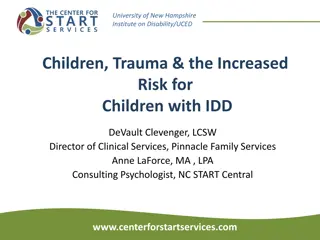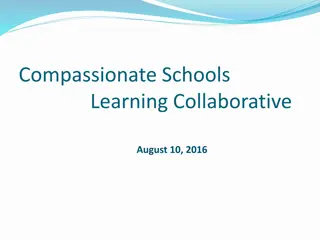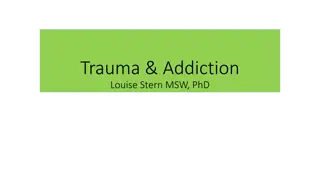Understanding Childhood Trauma and Its Impact on Mental Health
Childhood trauma, abuse, neglect, and their repercussions are crucial topics in child and adolescent psychiatry. The content delves into the definitions of trauma, child abuse, and related disorders, exploring their effects on individuals across the lifespan. It highlights the importance of recognizing trauma, understanding assessment tools for diagnosis, and implementing standard care for treating trauma-related disorders in children. Additionally, it addresses the significant findings of the ACES study on the correlation between childhood maltreatment and leading causes of death in adults.
Download Presentation

Please find below an Image/Link to download the presentation.
The content on the website is provided AS IS for your information and personal use only. It may not be sold, licensed, or shared on other websites without obtaining consent from the author. Download presentation by click this link. If you encounter any issues during the download, it is possible that the publisher has removed the file from their server.
E N D
Presentation Transcript
Childhood Abuse, Trauma, Neglect, and Sequelae Kelley Volpe MD Child and Adolescent Psychiatry Chief Fellow
Educational Objectives Examine the impact of childhood trauma and mental illness on the life span Recognize trauma related disorders and understand assessment tools utilized for diagnosis Review current treatments and learn standard of care for treating trauma-related disorders in children
CHILDHOOD TRAUMA IS IMPORTANT
What Is Trauma? DSM 5 Criterion A: Exposure to actual or threatened death, serious injury, or sexual violence in one or more of the following ways: 1. Directly experiencing the trauma events 2. Witnessing, in person, the event as it occurring to other 3. Learning that the traumatic events occurred to a close family member or close friend. In cases of actual or threatened death of a family member or friend, the event must have been violent or accidental 4. Experiencing repeated or extreme exposure to aversive details of the traumatic event (e.g. first responders collecting human remains; police officer repeatedly exposure to details child abuse) These events can include exposure to violence, natural disasters, divorce, being separated from parents, etc.
What Is Child Abuse? Physical child abuse is physical injury or intent to hurt a child as a result of hitting, kicking, shaking, burning or otherwise harming a child. Sexual child abuse is when a child is used by another person for that person's sexual satisfaction. Emotional child abuse is a pattern of behavior that hurts a child's emotional development or sense of well-being. Child neglect is failure to provide for a child's basic needs such as food, housing or schooling. Interpersonal violence includes actions when a person intentionally hurts another person. This includes community, intimate partner (domestic) violence, and bullying. Community violence is violence that happens in a child's neighborhood or community. Intimate partner violence is physical or sexual violence, the threat of violence, or emotional abuse towards a current or past spouse or intimate partner. Bullying is repeated negative acts by one or more children against another. Adverse Childhood Experiences AACAP.org
The ACES Study The Relationship of Childhood Abuse and Household Dysfunction to Many of the Leading Causes of Death in Adults Based at Kaiser Permanente in a primary care setting, 1995 to 1997 Survey of 13,494 members 70.5% responded Questions about childhood maltreatment and family dysfunction, as well as items detailing their current health status and behaviors. Survey information was combined with results of their physical examination to form the baseline data for the study.
Trauma is HIGHLY PREVALENT Psychological - 11.1% Physical 10.8% Sexual 22% Witnessed domestic violence to mother 12.5% Most common: substance use in household 25.6% Overall response rate to any category 52.1%
We Treat a HIGH RISK Patient Population Parent characteristics: young age low education single parenthood large number of dependent children low income History of abuse or mental illness Poor parenting skills Transient care takers Community violence and poverty Chronic medical problems and special needs
Trauma INCREASES Future Morbidity and Mortality Increased risk of activities that lead to worse health outcomes as adult Smoking Not exercise Obesity Increased risk of depression and suicide Risk increases with amount of violence to which one is exposed These high risk activities and symptoms can be conceptualized as ways of coping with trauma
Fig. 2. Potential influences throughout the lifespan of adverse childhood experiences. Vincent J Felitti MD, FACP, Robert F Anda MD, MS, Dale Nordenberg MD, David F Williamson MS, PhD, Alison M Spitz MS, MPH, Valerie Edwards BA, Mary P Koss PhD, James S Marks MD, MPH Relationship of Childhood Abuse and Household Dysfunction to Many of the Leading Causes of Death in Adults: The Adverse Childhood Experiences (ACE) Study American Journal of Preventive Medicine, Volume 14, Issue 4, 1998, 245 258 http://dx.doi.org/10.1016/S0749-3797(98)00017-8
AWARENESS Is Key Early intervention improves outcomes Screening and Assessment Trauma history is often missed Knowledge is crucial for effective risk assessment and treatment planning Improves secondary prevention Anticipatory guidance Appropriate referrals Working with this population can increase provider burden Awareness and self-care can improve this
IMPACT OF CHILDHOOD TRAUMA ON DEVELOPMENT
Framework Studies: Wide range of ages, trauma types, symptoms, and diagnoses Small sample sizes Data: Many conflicting theories Some conflicting results Some consistent trends Neuroendocrine is more established than neuroanatomy
Stress Response and the Brain Activates the catecholamine system/sympathetic nervous system Releases corticotropin releasing hormone which activates the HPA axis Cortisol is released These changes lead to adverse brain development Neuronal and structural Some suggest that new pathways for resilience may be formed
HPA Axis and Trauma Key Finding: Cortisol is increased in maltreated children and decreases in adults with PTSD Theories Children and adults have different responses to stress Increase is an acute response and the decrease develops over time due to neurodevelopmental effects of trauma Due to down regulation of receptors from chronic elevation blunts ACTH response Adrenal insufficiency despite consistent elevated ACTH response Other noted effects on puberty as well
Neuroanatomy and Trauma Key Findings: Hippocampal atrophy in adults with PTSD but not children Children have smaller brain volumes overall Theories Adult effect is related to a comorbidity (such as SUD) The change happens over time and/or is the result of developmental changes Decreased hippocampal size predisposes to PTSD Other noted effects on the amygdala and ACC as well as smaller PFC and corpus callosum
Take Home Points More evidence and research is needed Childhood PTSD is different from Adult PTSD Consequences are evolving Childhood maltreatment effects most areas of development Physical Social Emotional Cognitive
ASSESSMENT OF CHILDHOOD TRAUMA RELATED DISORDERS
Trauma and Stressor Related Disorders Reactive Attachment Disorder Disinhibited Social Engagement Disorder Posttraumatic Stress Disorder Acute Stress Disorder Adjustment Disorders Other and Unspecified Complex PTSD/Developmental Trauma Disorder
Resick, P. A., Bovin, M. J., Calloway, A. L., Dick, A. M., King, M. W., Mitchell, K. S., et al. (2012). A critical evaluation of the complex PTSD literature: Implications for DSM-5. Journal of Traumatic Stress, 25(3), 241-251. doi:10.1002/jts.21699
Trauma Related Symptoms Internalizing Depression/Anxiety Social withdrawal Feelings of loneliness, guilt, low worth Sad, nervous, fearful Difficulty concentrating Changes in sleeping or eating patterns Unexplained physical symptoms, i.e., headaches and stomach aches, not due to a medical condition Externalizing Conduct/Oppositional behaviors Physical aggression Destruction of property Substance use Running away from home
Clinical Screening What is the scariest thing that has ever happened to you? Has anything scary or upsetting happened since our last visit? (add to your family/child if asking parents) Do you know of any traumatic experiences your child has gone through? Has there ever been a time when you were (your child was) scared for your (his or her) life? Has anyone ever touched you in ways you did not want to be touched? Does [known traumatic event] ever bother or upset you these days?
Screening Forms FAQs How do you use screening forms? To screen To monitor over time What are good initial and trauma screening forms? Childhood Stressful and Adverse Experiences Questionnaire Children s Impact of Events Scale (8) (CRIES 8) SCARED Why are these good? Valid and Reliable Quick and FREE
Childhood Stressful and Adverse Experiences Questionnaire illinoisAAP.org
CRIES-8 Modified from an adult impact of events scale Children 8 and above Self reported Asks about the last 7 days
SCARED Anxiety screening that separates subsets: Panic disorder/Significant somatic symptoms Generalized anxiety disorder Separation anxiety disorder Social anxiety School avoidance Self and Parent rated forms
Other Mood and Anxiety Screening Forms Spence Child Anxiety form Comes in pre-school age Subscales include OCD Vanderbilt Includes subscales for anxiety, ODD, conduct, and depressive symptoms UCLA PTSD Reaction Index Combination of screening for trauma, PTSD, and diagnostic interview
Trauma Informed Care? A program, organization, or system that is trauma- informed: Realizes the widespread impact of trauma and understands potential paths for recovery Recognizes the signs and symptoms of trauma in clients, families, staff, and others involved with the system Responds by fully integrating knowledge about trauma into policies, procedures, and practices Seeks to actively resist re-traumatization. A trauma-informed approach can be implemented in any type of service setting or organization and is distinct from trauma-specific interventions or treatments that are designed specifically to address the consequences of trauma and to facilitate healing. SAMHSA.gov
PTSD Medications for Children SSRIs ?some evidence for adjunctive Negative Prazosin nightmares, hyperarousal Propranolol overall symptom decrease SGAs risperidone and quetiapine Clonidine re-enactment Guanfacine - re-experiencing, hyperarousal, nightmares Carbamazepine sexual trauma Divalproex sodium overall reduction Few Positive Strong Evidence
Strawn JR, Keeshin BR, DelBello MP, Geracioti TD Jr, & Putnam FW. (2010). Psychopharmacologic treatment of p osttraumatic stress disorder in children and adolescents: A review. Journal of Clinical Psychiatry, 71(7), 932-941.
When to Use Medications As second line or adjunct to therapy TREAT COMORBIDITIES
Types of Therapies TRAUMA BASED PSYCHOTHERAPY Cognitive Behavioral interventions for Trauma in Schools more peer support than parent Child-Parent Psychotherapy specifically for young children and an abused parent Cognitive-Based Cognitive Behavioral Therapy - more focused on reclaiming life activities Brief Psychoanalytic Psychotherapy - Includes both play therapy as well as sexual abuse topics Other Psychological debriefing : no harm or benefit Non-structured therapy: less effective Restrictive rebirthing, holding techniques, withholding food: harmful
Components of Effective Treatment DROPS Developmentally and culturally sensitive Resilience-based over deficit-based Overcoming avoidance by encouraging child to talk instead of waiting for them to be ready Parent inclusive Skills and safety focused to improve functioning in areas that are problematic (school, sleep, affective regulation, etc.)
The GOLD Standard Trauma-Focused Cognitive Behavioral Therapy For all ages and all traumas Multiple studies (including RCTs)confirming benefit https://tfcbt.musc.edu/
PRACTICE the TF-CBT Components Psychoeducation/Parenting skills Relaxation Skills Affective Expression Cognitive coping skills Trauma Narration In vivo mastery of trauma reminders Conjoint parent-child sessions Enhancing future safety.
The Trauma Narrative Must complete relaxation techniques and distress management skills first Can be done in many ways Drawn, comics, boards, written, recorded, play Based on child s capacity and developmental stage EXPOSURE HIERARCHY that is completed in a systematic way Start with the facts Add thoughts and feelings Add details to the more uncomfortable parts Final review and add how they feel now (what they learned, growth, strengths) Check anxiety level throughout and monitor for decrease over time
Conclusions Trauma is COMMON and should be screened for in all patients Trauma effects development in children due to the biological, psychological, and social consequences Medications are best used for co-morbidities Therapy is first line, particularly CBT
References AACAP.org. Child Abuse Resource Center. Frequently Asked Questions: What is Child Abuse? July 2016. http://www.aacap.org/aacap/Families_and_Youth/Resource_Centers/Child_Abuse_Resource_Center/FAQ.as px#question1 American Psychiatric Association. (2013). Diagnostic and statistical manual of mental disorders (5th ed.). Washington, DC: Author.Text citation: (American Psychiatric Association, 2013). Birmaher, B., Brent, D.A., Chiappetta, L., Bridge, J., Monga, S., and Baugher, M. (1999). Psychometric properties of the Screen for Child Anxiety Related Emotional Disorders (SCARED): a replication study. Journal of the American Academy of Child and Adolescent Psychiatry, 38(10). 1230-6. Cohen, J. A., Mannarino, A. P., & Deblinger, E. (2006). Treating trauma and traumatic grief in children and adolescents. New York: The Guilford Press. Felitti MD, F.,Vincent J., Anda MD, M.,Robert F., Nordenberg MD, D., Williamson MS, P.,David F., Spitz MS, M.,Alison M., Edwards BA, V., et al. (1998). Relationship of childhood abuse and household dysfunction to many of the leading causes of death in adults: The adverse childhood experiences (ACE) study. American Journal of Preventive Medicine, 14(4), 245-258. doi:http://doi.org/10.1016/S0749-3797(98)00017-8 Huemer, J., Edsall, S., Karnik, N. S., & Steiner, H. (2012). Childhood trauma. In W. M. Klykylo, & J. Kay (Eds.), Clinical child psychiatry (third ed., pp. 255) Wiley-Blackwell. Keeshin, B. R., & Strawn, J. R. (2014). Psychological and pharmacologic treatment of youth with posttraumatic stress disorder: An evidence-based review. Child and Adolescent Psychiatric Clinics of North America, 23(2), 399-411. doi:http://doi.org/10.1016/j.chc.2013.12.002 Resick, P. A., Bovin, M. J., Calloway, A. L., Dick, A. M., King, M. W., Mitchell, K. S., et al. (2012). A critical evaluation of the complex PTSD literature: Implications for DSM-5. Journal of Traumatic Stress, 25(3), 241- 251. doi:10.1002/jts.21699 Strawn JR, Keeshin BR, DelBello MP, Geracioti TD Jr, & Putnam FW. (2010). Psychopharmacologic treatment of posttraumatic stress disorder in children and adolescents: A review. Journal of Clinical Psychiatry, 71(7), 932-941. SAMHSA. Trauma-Informed Approach and Trauma-Specific Intervention. 8/14/2015. https://www.samhsa.gov/nctic/trauma-interventions Yule, W. (1997) Anxiety, Depression and Post-Traumatic Stress in Childhood. In I. Sclare (Ed) Child Psychology Portfolio. Windsor: NFER-Nelson
The End QUESTIONS?







